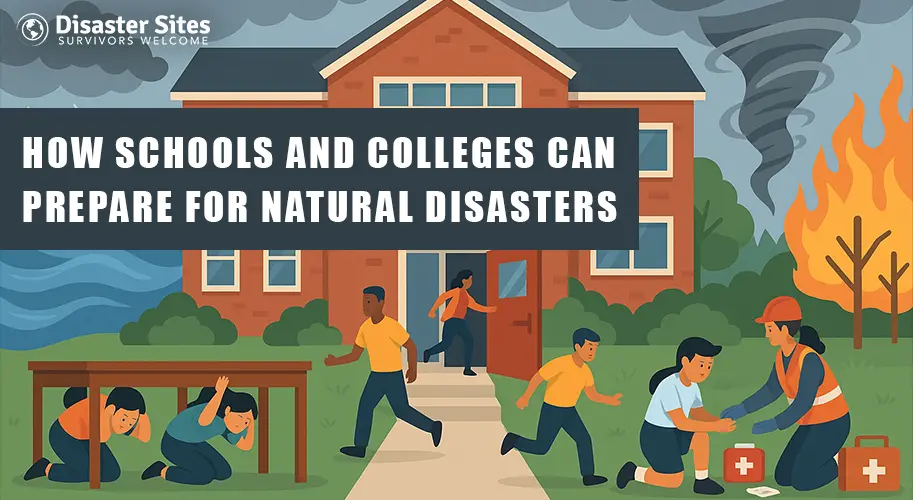We use cookies to personalise site content, social media features and to analyse our traffic. We also share information about your use of this site with our advertising and social media partners.
FEATURED
SPONSORED
VERIFIED

Oct 8 -
7 minutes, 16 seconds
-88 Views 3 Comments 0 Likes 0 Reviews

As natural disasters become more commonplace and more severe, they are equally unpredictable. Earthquakes, floods, cyclones, tornadoes, wildfires, heat waves… they can hit out of nowhere and bring the normal operation of our schools and colleges to a grinding halt. Schools and colleges are more than just places where we teach and learn. They represent a safe haven where we provide a structured and safe way for hundreds, perhaps thousands, of young people to spend their day.
In a time of disaster, the safety of our students, educators, and staff becomes paramount. A small disruption without preparation can cause serious panic, injuries, or long term damage to our structure. For that reason, disaster preparedness is no longer optional, it is a required responsibility of all school and educational institutions. Having the right plans and systems in place not only allows schools and colleges to limit damage but also potentially recover quicker to continue the delivery and provision of classes with little disruption.
Locations near the coastline could have the danger of tsunamis and cyclones. Areas near the hill and mountains may have landslides and earthquakes.
An appropriate risk assessment can assist you in identifying threats and what the threat could do with your campus, buildings, and students. This also includes assessing the strength of the school structures, the location of the exits, and the surrounding environment. Understanding what the potential dangers are beforehand allows institutions to prepare specific plans instead of a blanket approach.
For a beginner-friendly breakdown of why disasters occur, read "What Triggers Natural Disasters? A Beginner’s Guide".
Once the risks have been identified, the next requirement is to develop a clear disaster plan. A good disaster plan identifies what will be done, who will do it, and how it will be done.
Schools and colleges should:
A good disaster plan is brief, concise, typically communicated throughout the organization, and is not complex and/or comprehensive when disaster strikes.
A disaster plan is worthless if people don't know how to implement it. Conducting safety drills ensures that students, teachers, and staff can execute whatever it is they are supposed to do during the realization of an emergency. The drills include but are not limited to practicing earthquake "drop, cover, and hold" drills, fire evacuation drills, and lockdown drills.
Additionally, realistic training scenarios with hands-on training will prepare staff to administer first aid, learn how to use fire extinguishers, help students during the chaos, etc. If drills include collaboration and coordination with local police and fire departments and emergency services then drills have become more real and an opportunity to build relationships with trained responders. All of this training will help build confidence so that when disaster strikes, people can act rather than panic.
In a disaster, timely and effective communication is lifesaving. Schools and colleges should be able to communicate any urgent message to students, staff, and parents through a variety of methods, including a public address (PA) system, SMS alerts, telephone messages, emails, or possibly a mobile/app with push notifications as a method of communication.
Schools and colleges need to have an up to date emergency contact list to contact each parent and/or guardian as soon as possible. Schools and colleges also need to have clear and effective communication channels with local emergency services, so that if emergencies arise, these services can act quickly and respond to any necessary actions. All stakeholders, whether on or off campus should know what is happening to and what actions to take, in a timely manner.
Explore "The Impact of Advanced Technology and Artificial Intelligence in the Preservation of Life During a Natural Calamity" to see how innovations are shaping survival strategies.
Having the correct supplies can be very helpful in the first hours followed by a disaster. Schools and colleges should have emergency supplies and kits containing first aid supplies, bottled water, food, blankets, flashlights, and batteries.
Emergency equipment should be installed and regularly checked for any safety and rescue equipment you keep must be checked to ensure it works properly. Such safety equipment as fire extinguishers, fire alarms, emergency exit signs, and back up power supply systems could save everyone until responders arrive or you escape.
Being prepared can greatly reduce the impact of natural disasters when they occur but not always you can know about them. For schools and post secondary sites this means written plans, trained personnel and students, effective communication systems, and the necessary safety gear. Preparation leads to saving lives while making sure education happens with limited interruptions.
Practice safety drills allow students, teachers and staff to do exactly what they need to do when the moment of realization has happened that an emergency has occurred. Safety drills can practice a range of events including but not limited to earthquake drop, cover, and hold drills; fire evacuations; and lockdown procedures.

“To assist disaster survivors by providing a source for them to come together in time of need, to aid in the listing of events, information and other forms of assistance, and continuing support through the recovery process.”
Share this page with your family and friends.